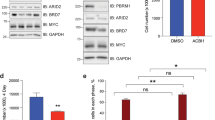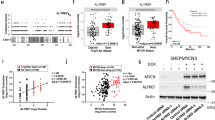Abstract
Mxi1 belongs to the Myc/Max/Mad network of proteins that have been implicated in the control of multiple aspects of cellular behavior. Previously, we had reported that the mouse mxi1 gene gives rise to two distinct transcript forms that can encode proteins with dramatically different functional abilities. The Mxi1-SR protein (here termed Mxi1-SRβ) can interact with Sin3/histone deacetylase and function as a potent transcriptional repressor and growth suppressor, while the Mxi1-WR protein lacks these activities. Here, we describe a new mxi1-derived transcript form (termed mxi1-SRα) whose expression is governed by its own promoter, resulting in a spatiotemporally distinct expression profile from that of the highly related mxi1-SRβ form. Moreover, the Mxi1-SRα protein product, with its unique Sin3 interacting domain, has a greater affinity than its Mxi1-SRβ counterpart for the Sin3 adapter proteins as well as an enhanced potential for transcriptional repression in transient reporter assays. Our identification of this novel Mxi1 isoform that results from alternative 5′ exon usage adds an additional layer of complexity to the Mad/Mxi1 family. In addition, our findings warrant re-evaluation of mxi1 expression patterns on the cellular level and its status in human cancer samples, with a renewed focus on the distinct isoforms.
This is a preview of subscription content, access via your institution
Access options
Subscribe to this journal
Receive 50 print issues and online access
$259.00 per year
only $5.18 per issue
Buy this article
- Purchase on Springer Link
- Instant access to full article PDF
Prices may be subject to local taxes which are calculated during checkout





Similar content being viewed by others
References
Alland L, Muhle R, Hou Jr H, Potes J, Chin L, Schreiber-Agus N and DePinho RA . (1997). Nature, 387, 49–55.
Antequera F and Bird A . (1999). Curr. Biol., 9, R661–R667.
Ariyanayagam-Baksh SM, Baksh FK, Swalsky PA and Finkelstein SD . (2003). Mod. Pathol., 16, 992–995.
Auffray C and Rougeon F . (1980). Eur. J. Biochem., 107, 303–314.
Ayer DE, Laherty CD, Lawrence QA, Armstrong AP and Eisenman RN . (1996). Mol. Cell. Biol., 16, 5772–5781.
Ayoubi TA and Van De Ven WJ . (1996). FASEB J., 10, 453–460.
Baudino TA and Cleveland JL . (2001). Mol. Cell. Biol., 21, 691–702.
Benson LQ, Coon MR, Krueger LM, Han GC, Sarnaik AA and Wechsler DS . (1999). J. Biol. Chem., 274, 28794–28802.
Billin AN, Eilers AL, Queva C and Ayer DE . (1999). J. Biol. Chem., 274, 36344–36350.
Boue S, Letunic I and Bork P . (2003). Bioessays, 25, 1031–1034.
Carrozza MJ, Utley RT, Workman JL and Cote J . (2003). Trends Genet., 19, 321–329.
Corpet F . (1988). Nucleic Acids Res., 16, 10881–10890.
Cowley SM, Kang RS, Frangioni JV, Yada JJ, DeGrand AM, Radhakrishnan I and Eisenman RN . (2004). Mol. Cell. Biol., 24, 2698–2709.
David G, Alland L, Hong SH, Wong CW, DePinho RA and Dejean A . (1998). Oncogene, 16, 2549–2556.
Eilers AL, Billin AN, Liu J and Ayer DE . (1999). J. Biol. Chem., 274, 32750–32756.
Grandori C, Cowley SM, James LP and Eisenman RN . (2000). Annu. Rev. Cell Dev. Biol., 16, 653–699.
Guarente L . (1983). Methods Enzymol., 101, 181–191.
Harper SE, Qiu Y and Sharp PA . (1996). Proc. Natl. Acad. Sci. USA, 93, 8536–8540.
Hurlin PJ, Queva C and Eisenman RN . (1997). Genes Dev., 11, 44–58.
Hurlin PJ, Queva C, Koskinen PJ, Steingrimsson E, Ayer DE, Copeland NG, Jenkins NA and Eisenman RN . (1995). EMBO J., 14, 5646–5659.
Hurlin PJ, Zhou ZQ, Toyo-oka K, Ota S, Walker WL, Hirotsune S and Wynshaw-Boris A . (2003). EMBO J., 22, 4584–4596.
Kingston RE . (2004). Current Protocols in Molecular Biology Online. John Wiley and Sons: New York.
Knoepfler PS and Eisenman RN . (1999). Cell, 99, 447–450.
Krakauer DC and Nowak MA . (1999). Semin. Cell Dev. Biol., 10, 555–559.
Laherty CD, Yang WM, Sun JM, Davie JR, Seto E and Eisenman RN . (1997). Cell, 89, 349–356.
Land H, Parada LF and Weinberg RA . (1983). Nature, 304, 596–602.
Landry JR, Mager DL and Wilhelm BT . (2003). Trends Genet., 19, 640–648.
Lee C, Atanelov L, Modrek B and Xing Y . (2003). Nucleic Acids Res., 31, 101–105.
Lee TC and Ziff EB . (1999). J. Biol. Chem., 274, 595–606.
Luo Q, Harmon E, Timms BG and Kretzner L . (2001). J. Urol., 166, 1071–1077.
Luscher B . (2001). Gene, 277, 1–14.
Mao DY, Watson JD, Yan PS, Barsyte-Lovejoy D, Khosravi F, Wong WW, Farnham PJ, Huang TH and Penn LZ . (2003). Curr. Biol., 13, 882–886.
McMahon SB, Wood MA and Cole MD . (2000). Mol. Cell. Biol., 20, 556–562.
Modrek B and Lee C . (2002). Nat. Genet., 30, 13–19.
Modrek B and Lee CJ . (2003). Nat. Genet., 34, 177–180.
Oster SK, Ho CS, Soucie EL and Penn LZ . (2002). Adv. Cancer Res., 84, 81–154.
Pirity M, Blanck J and Schreiber-Agus N . Current Topics in Microbiology and Immunology Eisenman RN (ed). Springer Verlag: Berlin, (in press).
Prochownik EV, Eagle Grove L, Deubler D, Zhu XL, Stephenson RA, Rohr LR, Yin X and Brothman AR . (1998). Genes Chromosomes Cancer, 22, 295–304.
Quandt K, Frech K, Karas H, Wingender E and Werner T . (1995). Nucleic Acids Res., 23, 4878–4884.
Queva C, Hurlin PJ, Foley KP and Eisenman RN . (1998). Oncogene, 16, 967–977.
Resch A, Xing Y, Modrek B, Gorlick M, Riley R and Lee C . (2004). J. Proteome Res., 3, 76–83.
Sambrook J, Fritsch EF and Maniatis T . (1989). Molecular Cloning: A Laboratory Manual 2nd edn. Cold Spring Harbor Laboratory Press: Cold Spring Harbor, New York.
Schreiber-Agus N, Chin L, Chen K, Torres R, Rao G, Guida P, Skoultchi AI and DePinho RA . (1995). Cell, 80, 777–786.
Schreiber-Agus N, Chin L, Chen K, Torres R, Thomson CT, Sacchettini JC and DePinho RA . (1994). Oncogene, 9, 3167–3177.
Schreiber-Agus N, Meng Y, Hoang T, Hou Jr H, Chen K, Greenberg R, Cordon-Cardo C, Lee HW and DePinho RA . (1998). Nature, 393, 483–487.
Skotheim RI, Monni O, Mousses S, Fossa SD, Kallioniemi OP, Lothe RA and Kallioniemi A . (2002). Cancer Res., 62, 2359–2364.
Smale ST . (1997). Biochim. Biophys. Acta., 1351, 73–88.
Sun L, Vitolo MI, Qiao M, Anglin IE and Passaniti A . (2004). Oncogene, 23, 4722–4734.
Thiagalingam S, Cheng KH, Lee HJ, Mineva N, Thiagalingam A and Ponte JF . (2003). Ann. NY Acad. Sci., 983, 84–100.
van Ingen H, Lasonder E, Jansen JF, Kaan AM, Spronk CA, Stunnenberg HG and Vuister GW . (2004). Biochemistry, 43, 46–54.
Yin X, Landay MF, Han W, Levitan ES, Watkins SC, Levenson RM, Farkas DL and Prochownik EV . (2001). Oncogene, 20, 4650–4664.
Acknowledgements
We thank Dr Art Skoultchi and Dr Kathy Zimmerman, as well as members of the Schreiber-Agus laboratory, for stimulating discussions and critical reading of the manuscript. We are indebted to Dr John Greally for the CpG island analysis, and to Christina Medina for technical help with cloning the human MXI1-SRα minimal promoter. This work was supported by NCI Grant 1 R01 CA92558 (NSA), and by funds from the New York Speaker's Fund for Biomedical Research (NSA). CDD is a recipient of a postdoctoral award from the International Agency for Research on Cancer, JB is a recipient of a predoctoral fellowship from the National Cancer Center, and AS is supported by the Medical Scientists Training Program Grant T32GM07288. Support from the Albert Einstein Cancer Center is also acknowledged.
Author information
Authors and Affiliations
Corresponding author
Rights and permissions
About this article
Cite this article
Dugast-Darzacq, C., Pirity, M., Blanck, J. et al. Mxi1-SRα: a novel Mxi1 isoform with enhanced transcriptional repression potential. Oncogene 23, 8887–8899 (2004). https://doi.org/10.1038/sj.onc.1208107
Received:
Revised:
Accepted:
Published:
Issue Date:
DOI: https://doi.org/10.1038/sj.onc.1208107
Keywords
This article is cited by
-
Rybp interacts with Hippi and enhances Hippi-mediated apoptosis
Apoptosis (2007)
-
Tissue, cell and stage specificity of (epi)mutations in cancers
Nature Reviews Cancer (2005)



